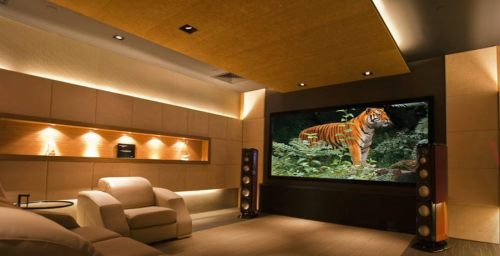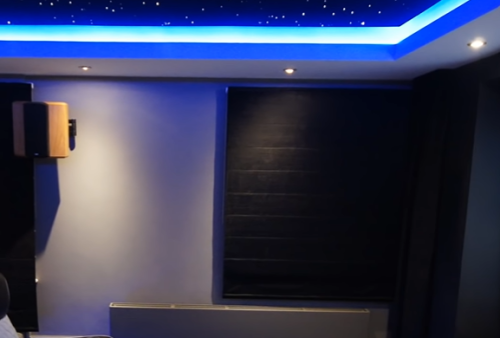Compared to other rooms, the living room is the best place to set up your home theater. However, a living room home theater setup is one tricky thing to do that can leave you frustrated. If you don’t get it right, you won’t get the best sound and visual experience.
Below are design tips our technical team will share with you in this article.
A Living Room Home Theater Setup
When setting up a living room with a home theater, you need to be attentive to details because one thing can get your setup all wrong. You might even mess up the available space that will make the whole room feels uninviting. For a great home theater setup and living space, this is something you would want to avoid.
Since the living room is the primary room in the house for all sorts of activities and not just for entertainment, it would be best to make it minimalistic. At the same time, it must offer an immersive audio experience similar to that of a music studio.
Important Factors to Consider
When setting up your living room with a home theater system, below are the factors you should consider.
Space Shape and Area
When you want to convert or bring your home theater in a living room, the first thing you need to factor in is the space shape and area. Lower-frequency sounds don’t work excellently in a square room because they will create an unbalanced hearing. Rather, rectangular rooms are the best option for a home theater setup.

Also, you wouldn’t want a large system that would take up the available space in the room. You need to pay attention to the flooring type because it can affect how sound travel, especially if you use a floorstanding speaker. Carpets are best for flooring because it prevents soundwaves from bouncing frequently.
Also check: Getting more profit selling your home with home theater
Sound System
Do you want an all-inclusive home theater system with several wires, soundbars, or stand-alone speakers? You can find tons of excellent wireless in-wall, cabinet, or floorstanding speakers in the market that will fit into your living space.
Wireless speakers are great for living rooms because they provide a clutter-free experience. Soundbars are also a great choice because they are sleek and portable.
(To enjoy movies better without being an annoyance to the neighborhood, here are the ways to soundproof your home theater)
Acoustics
Rectangular rooms are best for a home theater system setup. The setup must not choke the room to prevent the speakers’ bass from coming out hazy. After setting up the speakers, consider how available space will cater to the acoustics of your audio system.

Lighting
Allowing too much light into the room from the windows can affect your visual experience. If you want to convert your living room into a home cinema any time of the day, our expert team suggests getting a curtain or a dark bind to control lighting if you have too many windows.
(If you want impressive home theater system options, you can check top-notch Blu-ray home theater systems listed here)
Tips and Tricks
Hide Wires and Other Components
If you have wired speakers and lots of other wires, there are ways to hide them like using large decorations for home theater. Wires can create big problems in a home theater system because it leaves the area cluttered. However, you need to be careful when to avoid the wires from getting too hot and blowing up.
You can manufacture wire covers to dress up the cords, mount the wires, or run the wires along the walls. These tricks will hide the wires successfully without any issue.
Soundbar For Small Spaces
If you don’t want to deal with cabinet or floorstanding speakers in your small space, it would be best to opt for soundbars. Soundbars provide nearly the same incredible sound output as other speakers, and the good thing about them is that they are sleek and portable.
Utilize the Placement of Audio Devices to Optimize Sound
Speaker placement is a crucial factor that affects sound distribution. When placing speakers, it’s best not to keep them close to each other. If they are too close, they could be signal interference.

Therefore, you need to place them inches apart, preferably around the corners of the room.
Speaker Set for a Complete Setup
Stand-alone speakers are great, but getting a complete set of speakers can boost the overall sound experience of the room. When fully setup, the speakers will fill the room, and you can listen anywhere within the room.
Use a Projector for Bigger Screen
Sometimes, the seating arrangement of a large room can keep some people disadvantaged, preventing them from enjoying the view. The TV’s location is crucial, and the seating arrangement is even more vital.
If the distance from the TV to the seats is far, it would be best to use a projector for the bigger screen. Plus, ensure that the TV is set in the ideal eye height to prevent neck strains [1].
Use Thick Drapes that Block Out Light
Our team recommends thick drapes to block out light from the outside, so that the room feels like a real theater-like venue.
(If you are setting up with a television, you can also check excellent entertainment center intended for wall mounted TVs here)
Conclusion
Understanding the various aspects of a living room home theater setup will help you create the best sound experience. Thankfully, you need not be scared of setting up your home theater system wrongly because with just a few tweaks and replacements, you can enjoy your living space as a home cinema.
Want to maximize your use of a home theater room? Then, these pages can be helpful for you!
